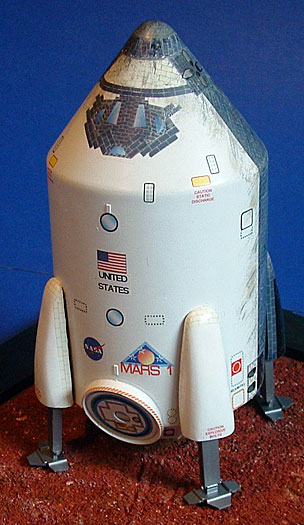|
1/72 scale
scratchbuilt styrene
MARS 1
by David Hanners
|
 |
|
MARS 1 |

HyperScale is proudly supported by Squadron
This is a scratchbuilt model of one of the many design concepts being
studied for a manned Mars lander. As designs go, it ain’t real sexy, but
I figured I should do one of these before I move on to a version with
exposed fuel tanks and other details.
 The
main body is .015 sheet styrene, rolled into a cylinder and three
truncated cones. One of the truncated cones makes up the top, and the
rounded nose was made from Miliput, which was shaped and sanded. Two
truncated cones make up the bottom propulsion section. One is the
exterior and it was given external ribbed detail with half-round styrene
strip and other bits and pieces. The
main body is .015 sheet styrene, rolled into a cylinder and three
truncated cones. One of the truncated cones makes up the top, and the
rounded nose was made from Miliput, which was shaped and sanded. Two
truncated cones make up the bottom propulsion section. One is the
exterior and it was given external ribbed detail with half-round styrene
strip and other bits and pieces.
The other truncated cone makes up the recessed “well” that holds the
nozzle. The nozzle was scavenged from an old “Space:1999” Eagle and was
cut and sanded to shape.
The egress hatch was made from the bottom of a plastic pill bottle, cut
to shape and faired in with Super Glue. The landing legs and footpads
were made from strip styrene, and the landing gear fairings were made
from sheet styrene that was heat-formed over a carved wooden mold.
|
Home
| What's New |
Features |
Gallery |
Reviews |
Reference |
Forum |
Search